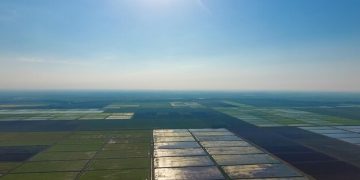Federal Disaster Relief: Government Response to Natural Disasters

Federal disaster relief efforts encompass a wide range of actions undertaken by the U.S. government to support communities and individuals affected by natural disasters, including financial assistance, temporary housing, and infrastructure restoration.
When natural disasters strike, the aftermath can be devastating. Understanding how the federal disaster relief efforts are structured and implemented can provide clarity and hope during uncertain times.
Understanding Federal Disaster Relief Efforts
Federal disaster relief is a multi-faceted approach designed to aid states, communities, and individuals in the wake of natural disasters. This assistance is crucial for recovery and rebuilding efforts.
The primary goal of these efforts is to alleviate suffering and facilitate the return to normalcy following events like hurricanes, floods, wildfires, and earthquakes. The process involves various federal agencies working in coordination with state and local governments.

Key Agencies Involved
Several federal agencies play critical roles in disaster relief. Understanding their responsibilities can help you navigate the system more effectively.
- FEMA (Federal Emergency Management Agency): Leads the federal government’s response to disasters and provides assistance to individuals and communities.
- SBA (Small Business Administration): Offers low-interest disaster loans to homeowners, renters, and businesses to repair or replace damaged property.
- National Guard: Assists with search and rescue, security, and distribution of supplies as directed by the governor of each state.
These agencies collaborate to provide a comprehensive safety net for those affected by natural disasters, ensuring that resources are allocated efficiently and effectively.
In conclusion, federal disaster relief efforts are essential for supporting communities during their most vulnerable times. By coordinating resources across multiple agencies, the government aims to minimize suffering and expedite recovery.
The Stafford Act and Presidential Disaster Declarations
The Robert T. Stafford Disaster Relief and Emergency Assistance Act is the cornerstone of federal disaster response. It outlines the procedures for declaring disasters and providing federal aid.
This act empowers the President to issue major disaster declarations or emergency declarations upon request from a state or tribal government. These declarations unlock federal resources to supplement state and local efforts.
Types of Declarations
Understanding the different types of declarations is important for knowing what aid is available.
A major disaster declaration is issued when a disaster is of such severity and magnitude that it exceeds the state and local government’s capacity to respond. This declaration triggers access to a broad range of federal assistance programs.
An emergency declaration is issued for any occasion or instance where, in the determination of the President, federal assistance is needed to supplement state and local efforts and capabilities to save lives and to protect property and public health and safety, or to lessen or avert the threat of a catastrophe in any part of the United States.
- Individual Assistance: Aid to individuals and households.
- Public Assistance: Aid to state and local governments and certain private nonprofit organizations for emergency work and the repair or replacement of disaster-damaged facilities.
- Hazard Mitigation Assistance: Funding for projects that reduce the risk of future damage from disasters.
These declarations are vital for ensuring that communities receive the necessary support to recover and rebuild after a disaster. The Stafford Act provides the legal framework for these actions.
In conclusion, the Stafford Act and presidential disaster declarations are critical components of federal disaster relief. They provide the legal and procedural basis for mobilizing federal resources to assist states and communities in times of crisis.
FEMA’s Role in Disaster Response
The Federal Emergency Management Agency (FEMA) is at the forefront of federal disaster response efforts. FEMA coordinates the government’s resources to assist those affected by disasters.
FEMA’s mission is to support citizens and first responders to ensure that as a nation we work together to build, sustain, and improve our capability to prepare for, protect against, respond to, recover from, and mitigate all hazards.”
How FEMA Assists Individuals
FEMA provides a variety of assistance programs for individuals and households. These programs are designed to help cover essential needs and facilitate recovery.
- Disaster Assistance: Financial assistance for housing, medical expenses, and other disaster-related needs.
- Transitional Sheltering Assistance: Temporary housing in hotels or other facilities.
- Disaster Unemployment Assistance: Benefits for those who lost their jobs due to the disaster.
FEMA also works closely with state and local governments to assess damage, coordinate resources, and provide technical assistance. This collaboration is essential for ensuring a coordinated and effective response.

In conclusion, FEMA plays a central role in federal disaster response by coordinating resources and providing assistance to individuals and communities. Its efforts are critical for minimizing the impact of disasters and facilitating recovery.
Financial Assistance Programs After a Disaster
Financial assistance is a crucial component of federal disaster relief. Several programs are available to help individuals, families, and businesses recover financially after a disaster.
These programs are designed to cover a range of needs, from housing and medical expenses to business losses and infrastructure repairs. Understanding these options can help you access the support you need.
Key Financial Assistance Programs
Several federal agencies offer financial assistance programs to help those affected by disasters. Here are some of the most important ones:
- FEMA Individual Assistance: Grants for housing repairs, replacement of essential household items, and other disaster-related expenses.
- SBA Disaster Loans: Low-interest loans for homeowners, renters, and businesses to repair or replace damaged property.
- USDA Disaster Assistance: Programs to help farmers and ranchers recover from agricultural losses due to disasters.
These financial assistance programs are essential for helping individuals and communities rebuild their lives and livelihoods after a disaster. They provide a safety net and a pathway to recovery.
In conclusion, financial assistance programs play a vital role in federal disaster relief efforts. By providing resources to cover essential needs, these programs help individuals and communities recover financially after a disaster.
The Role of the National Guard
The National Guard plays a crucial role in disaster response, providing support to state and local authorities when needed. Its capabilities are essential for maintaining order, assisting with rescues, and distributing supplies.
The National Guard is a unique military force that operates under the command of the state governor unless federalized by the President. This dual role allows it to respond quickly and effectively to disasters within its home state.
How the National Guard Assists
The National Guard provides a wide range of support during disaster response. Its capabilities include:
Search and rescue operations, providing security and maintaining order, distributing essential supplies, assisting with evacuations, clearing debris and opening roadways.
The National Guard’s ability to mobilize quickly and deploy resources makes it an invaluable asset during times of crisis. Its presence can help stabilize the situation and provide much-needed assistance to affected communities.
In conclusion, the National Guard plays a critical role in federal disaster relief efforts. Its unique capabilities and dual role make it an essential component of the nation’s emergency response system, providing support to state and local authorities when needed most.
Challenges in Disaster Relief and How to Overcome Them
Despite the extensive efforts, disaster relief faces several challenges that can hinder its effectiveness. Addressing these challenges is critical for improving the response to future disasters.
These challenges include logistical issues, communication breakdowns, bureaucratic hurdles, and ensuring equitable distribution of resources. Overcoming these obstacles requires careful planning, coordination, and collaboration.
Addressing Common Challenges
Several strategies can help overcome the challenges in disaster relief, including:
- Improving Communication: Establishing clear and reliable communication channels between federal, state, and local agencies.
- Streamlining Processes: Simplifying application processes for disaster assistance to reduce bureaucratic delays.
- Enhancing Coordination: Strengthening coordination between different agencies to ensure a unified and efficient response.
By addressing these challenges proactively, the government can improve the effectiveness of disaster relief efforts and better support communities in their time of need.
In conclusion, while federal disaster relief efforts are extensive, they face several challenges that must be addressed to improve their effectiveness. By focusing on communication, streamlining processes, and enhancing coordination, the government can better support communities in their time of need.
| Key Point | Brief Description |
|---|---|
| 🏠 FEMA Assistance | Provides aid for housing, medical needs, and other disaster-related expenses. |
| 💰 SBA Loans | Offers low-interest loans for homeowners, renters, and businesses to repair damages. |
| 🛡️ National Guard | Assists with search and rescue, security, and distribution of supplies. |
| 📜 Stafford Act | Defines the process for major disaster declarations and federal aid allocation. |
Federal
▼
Federal Disaster Assistance is aid provided by the U.S. government to individuals and communities affected by natural disasters, helping them recover and rebuild.
▼
FEMA assists by offering financial aid for housing, medical expenses, and unemployment benefits for those who have lost jobs due to a disaster.
▼
The Stafford Act allows the President to declare major disasters and emergencies, unlocking federal resources for affected states and communities.
▼
You can apply for disaster relief through FEMA’s website, disaster assistance centers, or by calling their hotline. Make sure to gather necessary documents.
▼
The National Guard provides security, assists with rescues, and distributes essential supplies, supporting local authorities during disaster response efforts.
Conclusion
In summary, the federal government’s response to natural disasters involves a complex network of agencies, programs, and legal frameworks aimed at providing comprehensive support to affected communities. While challenges remain, ongoing efforts to improve coordination and communication are essential for building more resilient and prepared communities.





